Like a good book, a great adventure has chapters. Our Arctic voyage around the Svalbard Archipelago, about half-way between mainland Norway and the North Pole, had so many parts. I shared some of those in an earlier Arctic Adventure Diary and wanted to complete the picture for you now.

Not that I could ever begin to capture the full scope of what we experienced. Like all travels, many things remain as precious memories, but I hope that between these stories, our videos, and of course, the television episodes, you will get a real sense of what it is like up there and even perhaps inspired to travel there yourself.

As a bit of a summary, our Chimu Adventures expedition cruise began and ended in the settlement of Longyearbyen, on the main island of Spitsbergen. We flew in and out of Longyearbyen on a 3-hour charter flight from Copenhagen, along with many of our fellow passengers. After embarking the ship, we spent 7 nights cruising the archipelago and making numerous stops and shore excursions along the way.
The Itinerary
Our journey immediately took us west and then around the top of the archipelago in a north-east direction before looping back to the west to return to Spitsbergen. The itinerary had to be flexible – we always had to account for the weather at the time and access to the shore – we are dealing with sea ice and Mother Nature after all!

Every day was different; although our guides would always try to ensure we did two “excursions” – whether it was a zodiac cruise, a shore landing, kayaking, and one day we even did a polar plunge!

And each day we could enjoy educational sessions on the environment we were travelling through, presented by our team of expert guides including biologists, geologists and naturalists.

To give you a bit of an idea of the landscape we travelled through, here are some images of what we would see from the deck of the ship every day…


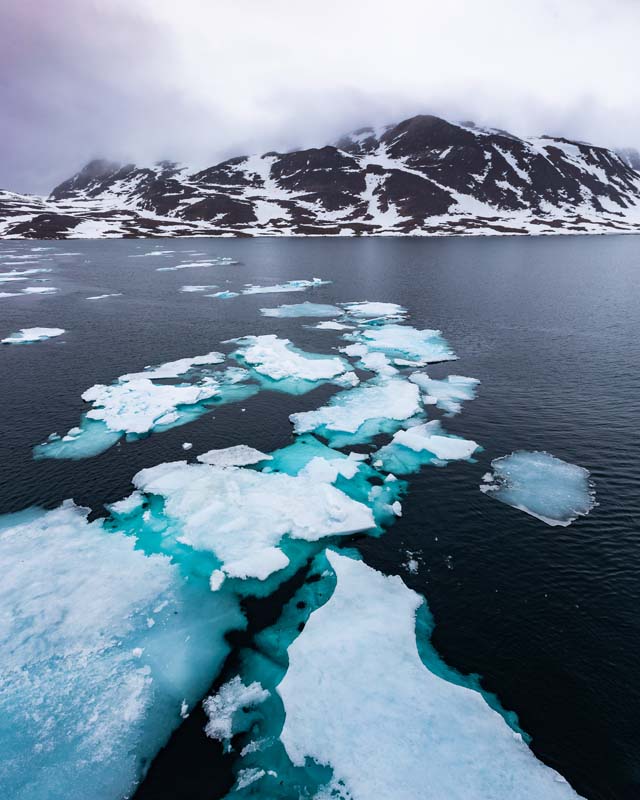

The Glaciers
I never expected there would be so many glaciers in the Arctic – they are literally everywhere. As we pulled up alongside the magnificent 14th of July glacier, I was lucky enough to spend an hour with the ship’s geologist Brian. Like all the guides I met, Brian’s depth of knowledge and his passion for the environment and adventure was inspiring.

“For anyone that is thinking of coming up to the Arctic, come with an open mind, and be prepared to see some of the most stunning landscapes that you will see anywhere in the world… Be prepared to adjust your head when the wind chill gets up.. You’re human and it’s really in control of us, rather than the other way around” Brian, On board Geologist.

A highlight for me was when I joined the kayak group for an afternoon, paddling in front of Magdalena Glacier. The group clearly knew I wasn’t a seasoned paddler, but good enough to pass the test to get a guernsey.

As soon as we hit the water, again there was a calmness that took over. The landscape felt so gentle.

As my fellow paddling mate Peter said:
“It all slips away. It feels like we’re submerged in the landscape. Totally dwarfed by the gigantic glacier, surrounded my low hanging clouds that shrouded the snowcapped mountains. There’s just something about being in the water in a kayak”
Shore Landings
I never expected so many shore landings, due to the danger of the Polar Bear. But the trip ran like a well-oiled machine.

Our guides would head off on zodiacs and scout the area on shore. Once deemed safe, we would follow. On land, there were very strict rules around where we could go, and how far we could walk – always guarded by an armed expedition crew member.

On land, in the middle of the Arctic, I felt part of the landscape. One day we (our film crew) decided to stay on the waters edge to film some footage of the area, while the main group went off for a walk. The sound of water trickled underneath the ice, and there was a complete stillness in the air.
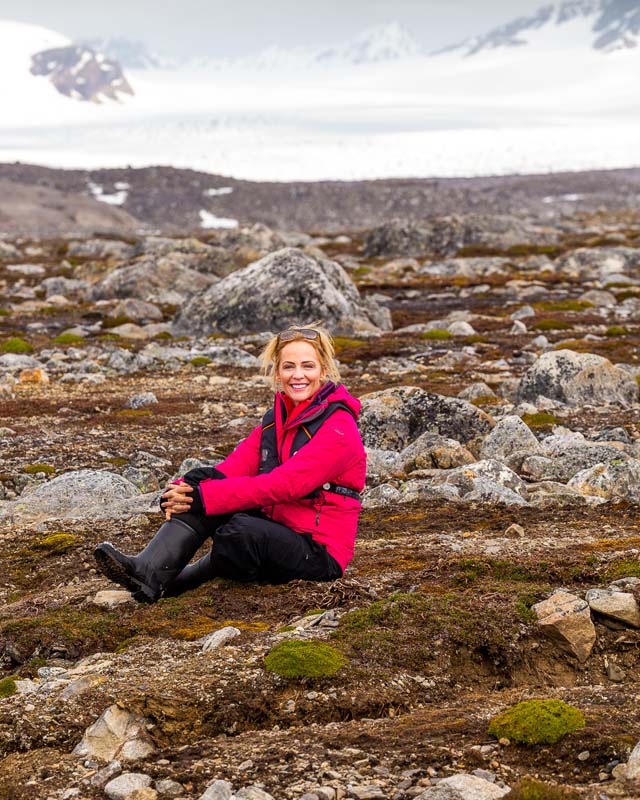
It was like having the entire planet to myself. I will never be able to explain that silence.
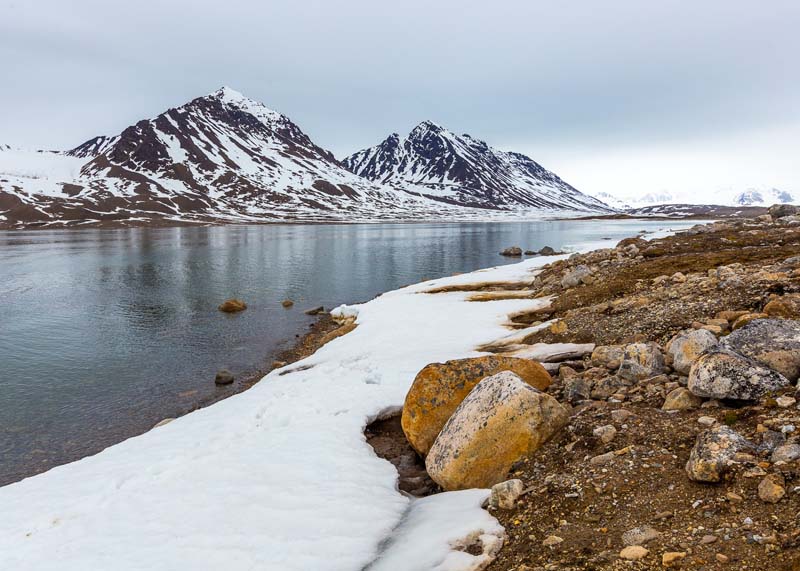
Wildlife
In the Arctic you have to be prepared to look for the wildlife. It doesn’t just appear, like in Antarctica.

As a result, I feel I was more present. I found myself on the deck for hours taking in the endless views of snowcapped mountains and glaciers looking for wildlife. But very quickly, I stopped “looking” and started “accepting” that is the beauty of the Arctic.
There is a simplicity in the environment. It feels gentle. The wildlife wanders around quietly; in harmony.
The Polar Bear
The most common question everyone has asked since my return has been “did you see a Polar Bear?”

Yes, on the very first morning – he not only walked along a long stretch of sea ice, he wandered along rocks and curled up for most of the day.

But there is so much more to the Arctic than Polar Bears. Every day we saw something different; something equally arresting.
The Beluga Whale
On our first morning, we were anchored in Billfjord and the light was dancing all over the water in another-worldly manner. My eyes focused on the ripples emerging – and right by the ice, was a pod of around 20 to 30 Beluga Whales; it looked like they were playing together.

Beluga Whales, also called white whales, have white skin that has adapted to its habitat in the Arctic, allowing them to blend in with the floating ice in the environment; camouflaging themselves as protection against the Polar Bears and Killer Whales.
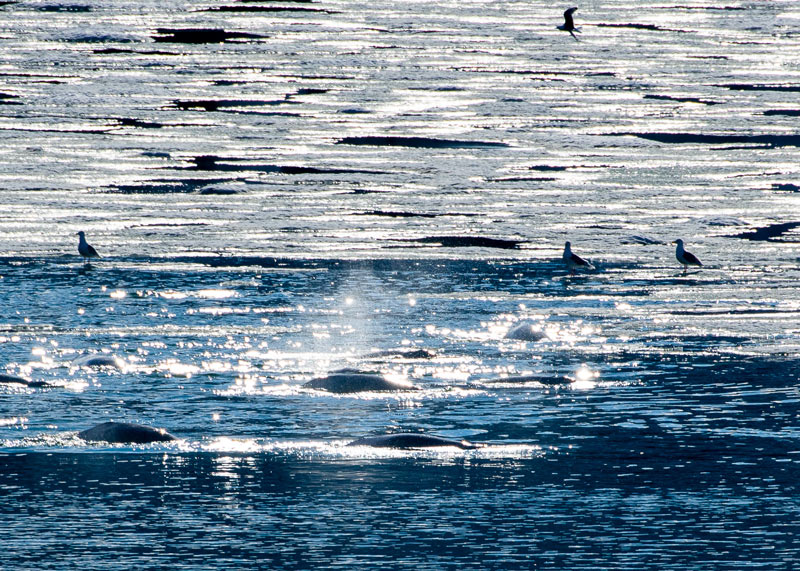
The Walrus
The story of the walrus is one of resilience. They were almost completely hunted out of the area hundreds of years ago, but since the practice was banned in the 70’s their numbers have grown again, and are now in their hundreds.

We were about half-way through our trip exploring the archipelago when we saw a group of about eight walruses basking in the sun on sea ice. It was an incredible sighting, as it felt like we were in the middle of the deep sea with not a lot of ice even around. And there they were. Some were swimming, others looked to be cuddling together on the ice.

“There is no reason why they shouldn’t continue to thrive in the future. In Svalbard where they have been protected there are a number of places where you cannot go on land because it’s where they’ve had their young. Many parts of Svalbard have been national parks for decades and you see the good effects of that… Mother Nature is so resilient it will keep fighting back – once you give it the chance”. Lars, Expedition Guide.
Who knew that the Walrus can eat up to 7,000 clams in a day? They can dive down 90 meters, and stay underwater for half an hour!
Sea Birds
I’ve never truly noticed birds before. Not like I did in the Arctic. And I fell in love with them. I would stand out by the ship and watch the Fulmars graciously glide alongside us. Keeping pace, as though saying hello.

I would spend hours wondering where they’d come from and where they were going.
Often they would rest on the ice, sometimes in their hundreds.

The Arctic Reindeer
An unforgettable brush with the wild for me, was on our last day when we were filming a group of Arctic Reindeer, and one walked all the way off the ice, over a field and over to me.

I was hunched down, not wanting to scare her away. The Arctic wind was cutting straight through her coat and I couldn’t help but wonder how they survive in such a place.
The history – Past and Present
I also never expected to be able to wander through so many relics from the past as we learnt about Svalbard’s history from whaling to coal mining. Plus Svalbard’s location has made it the jumping off point for some of history’s greatest explorers, such as the Norwegian explorer Amundsen who discovered the North Pole in 1911 after leaving from Ny-Alesund.

“They were real legends. They were motivated by curiosity, firstly, and by glory in a way too, they wanted to find out something nobody knew before – that was their main motivation. A burning desire to explore the world and see something nobody else has seen” Thomas, On board Polar Historian.
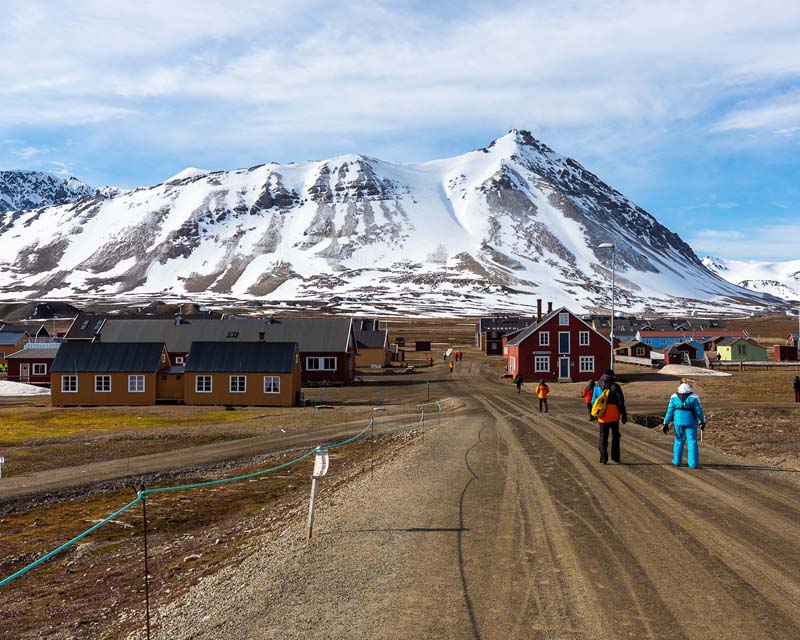
And it’s not just about the past, today Ny-Alesund is home to 30 people working at around ten different national scientific research bases analysing the world’s atmosphere. It certainly felt like we were at the pointy end of the environmental conversation when you see enormous NASA satellite dishes. I would have loved to have knocked on the door and interviewed the scientists, but they looked extremely busy!! (maybe next time!).
Travelling with like-minded people

Another highlight for me was being on board a ship with like-minded travellers. After each excursion we’d find ourselves de-briefing the experience; and sharing stories of other adventures. Talk about a well-travelled group of people. I reckon half of the 200 people on board had already been to Antarctica or were planning to go.


“This is a once in a lifetime – but I might come again! It’s so beautiful, it gets you. The camaraderie of the people and the smaller boat is just right. We were all late for breakfast because we were late out on the deck, soaking up the place. And I love the deep expertise of the guides, they have all got special information, expertise and qualifications and they are giving us lectures even when they’re walking around the ship. They know everything about everything, just full of so much information about glaciers, bird life…all the wildlife. As I said, this is a trip of a lifetime.” Tony (fellow passenger).
Giving back
I particularly loved the charity element of the Chimu Adventures trip. We had acclaimed Australian Artists Wendy Sharpe and Bernard Ollis on board, painting for an exhibition and auction that was held on the ship near the end of the trip.

All the proceeds went to their MAD (Make A Difference) Project, a foundation that micro-finances projects through Latin America, and the Mawson’s Hut Foundation. Since the company started, they’ve raised over a million dollars, and thanks to our efforts, that number is rising.

And finally, a fragile land with hope.
There were many deep conversations about what is happening to the planet. When you are in a place that is being affected by global warming faster than anywhere else, it really is impossible not to be moved.

Over the last summer, Norwegian Polar institute researchers found more than 200 dead reindeer in the Svalbard archipelago. They’re attributing it to climate change, saying rain in December was so unusual for that time of year that it froze the pastures when the weather got colder. The reindeer starved to death because their food had been frozen.

The conversation of climate change came up pretty much daily on our trip. Whether it was asking our expert guides, or general conversation with my fellow passengers and film crew while anchored in sea ice.

According to research, the Arctic is melting approximately 12 per cent per decade. And is being impacted doubly as fast as anywhere else in the world. The issue of course, it’s that the ice acts as a thermal protection against the sun’s radiation.
I came home deeply affected by what we’re all doing as a collective that is causing global warming to speed up. From my time in the Arctic, I made a commitment that the trip was the beginning of the conversation for me.

There is something about witnessing something first-hand that seeps into your soul, that no book, or research can ever do.
I can’t “un-see, un-know, or un-feel” what I experienced. I have now been handed the baton to try and do my bit for the planet.
But it was the stories of resilience that gave me hope. Like the walruses, and the whales whose numbers are now thriving since much of the archipelago became protected from 1972, Mother Nature will fight back if you give her a chance.

“We are all responsible for what is happening with the planet. Even being here. But we see these trips as a really important way to not only educate you, but so you can feel it – hopefully with that you will go home ambassadors and make those little changes that we all can make to effect the bigger picture for our environment, for our planet” Larse.
I would like to personally thank all of those who I met on board for allowing us to film this very special journey and share it with the world through our TV show. We would love to know if it has impacted you below in the comments?
DON’T FORGET to watch our full television episodes on our Arctic Voyage:
Photography and video thanks to Bruce Davis for Places We Go
These would all be fantastic places and animals to see. I have no doubt about that. The fact that all these people continue to discuss climate change, totally forgetting that it took avgas, petrol and diesel to get there shows how hypocritical people can be when it suits them.
Jen we watched your Actic Adventure with Chimu. Could you please tell me which 7 day
cruise you did. We thoroughly enjoyed it and would like to do the same one.
What a beautiful destination! The educational talks would be fascinating!